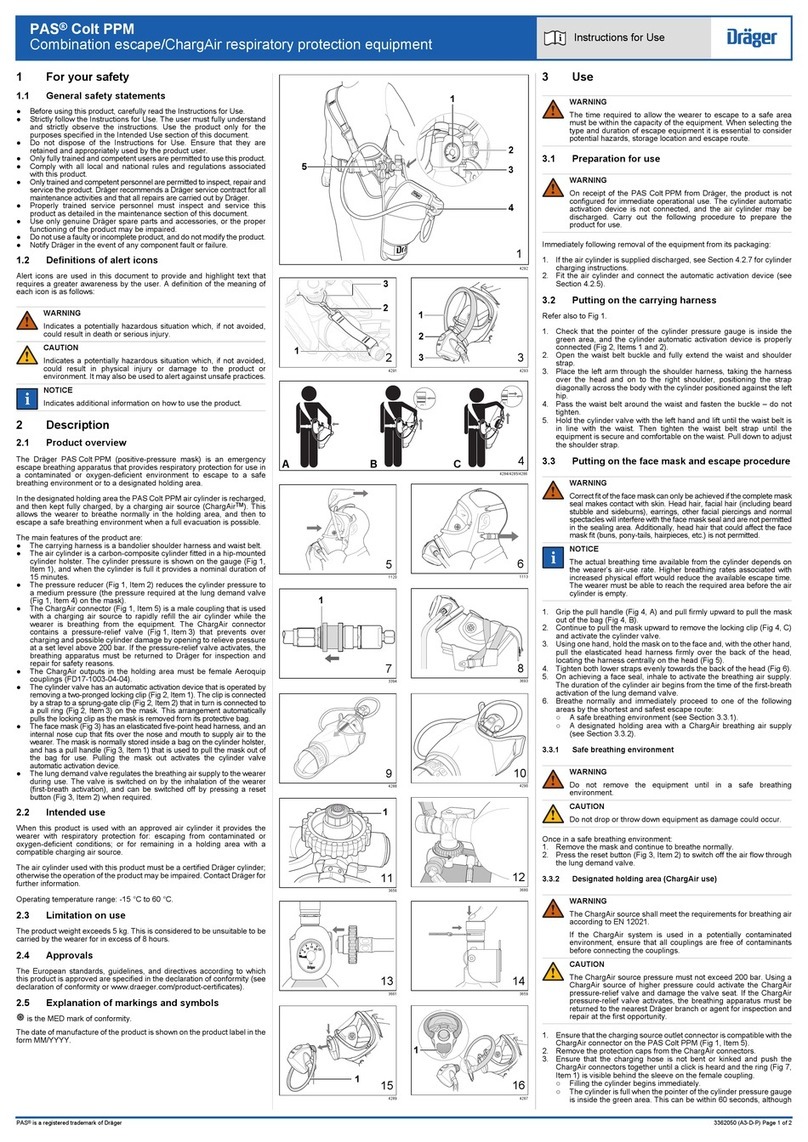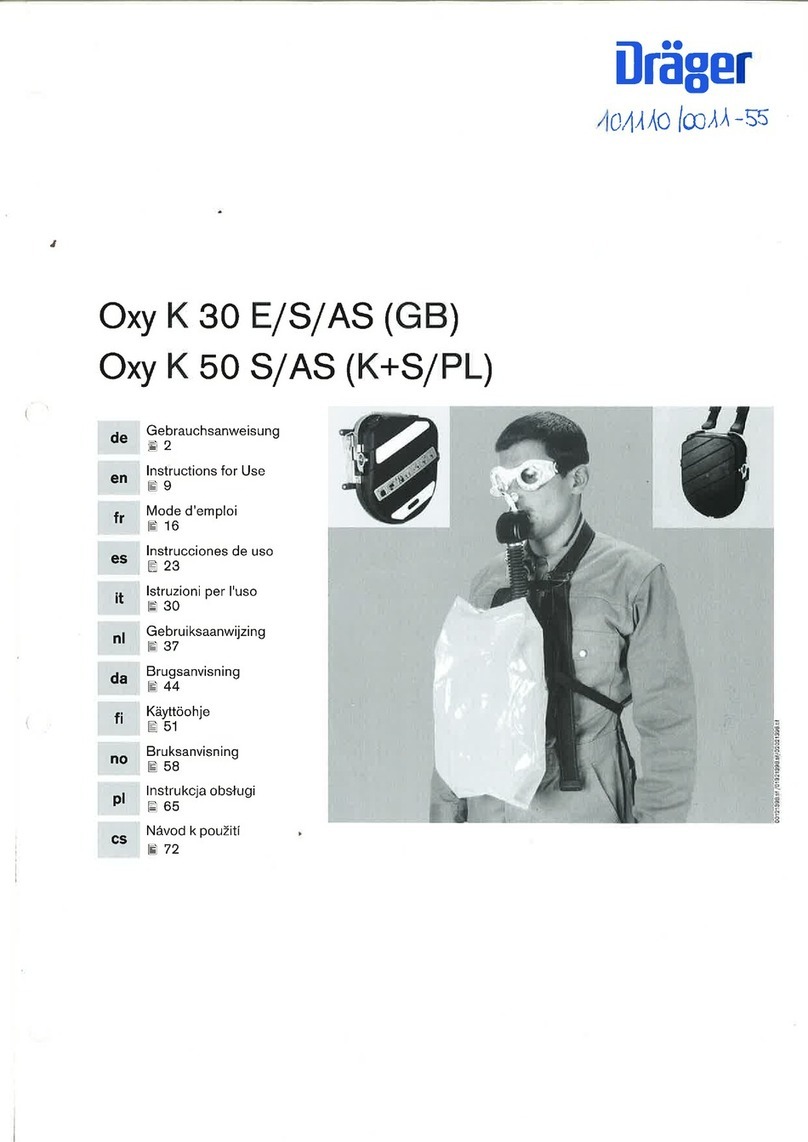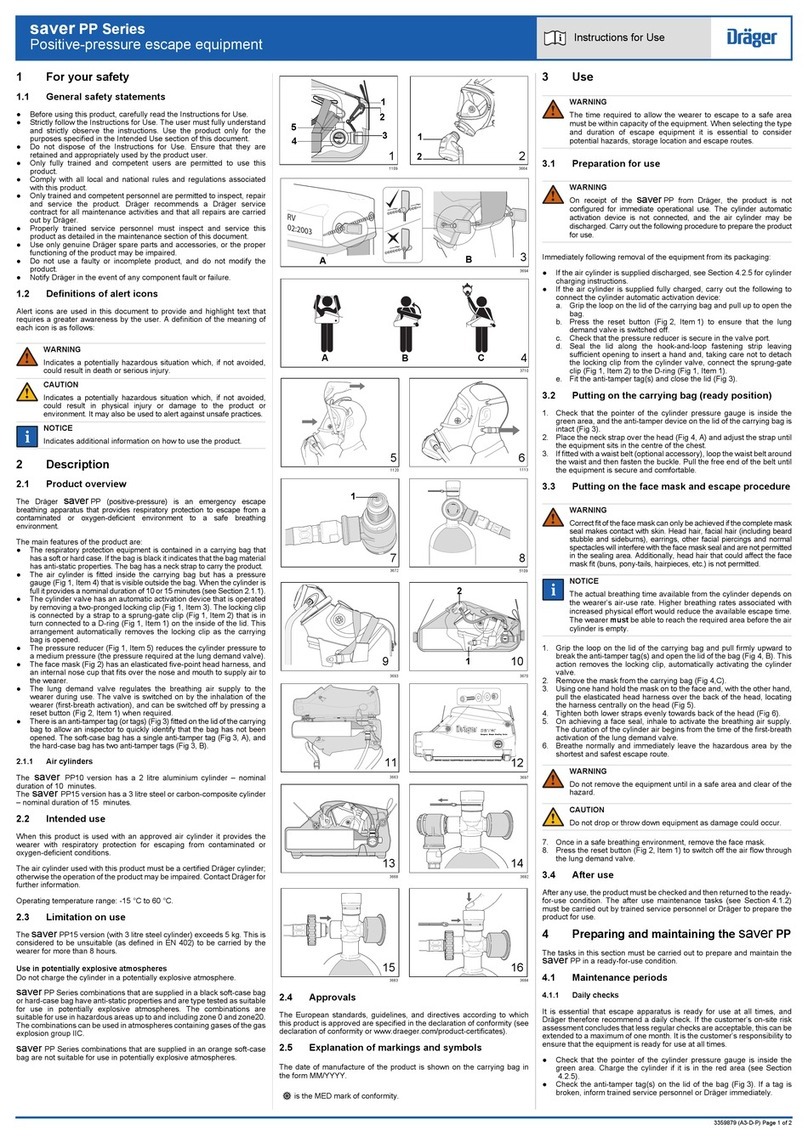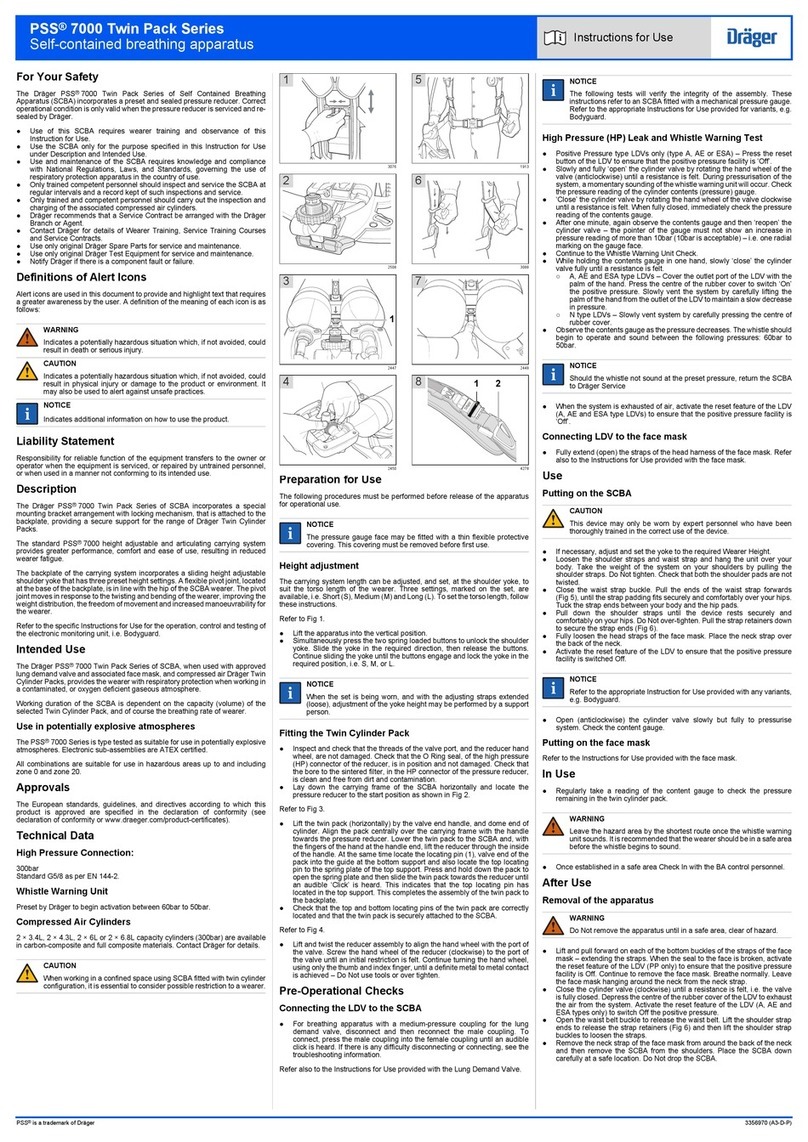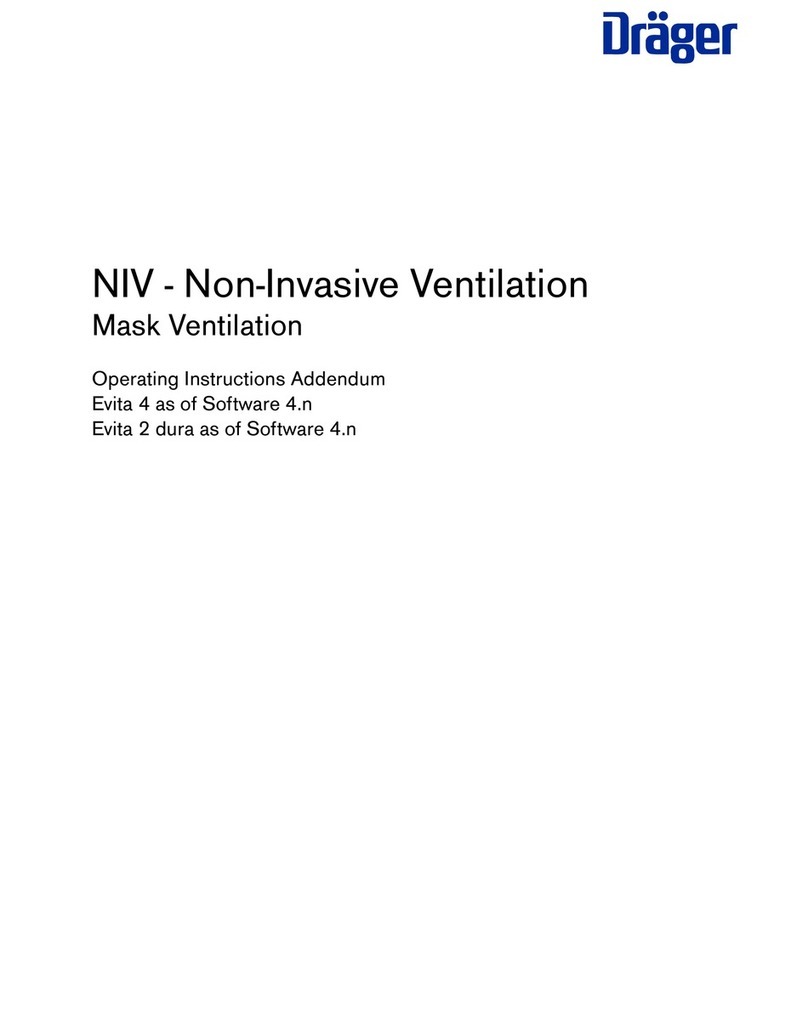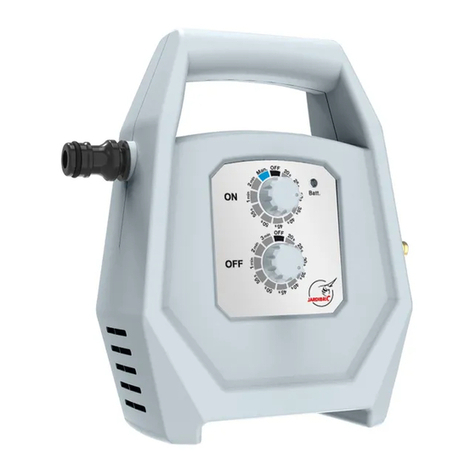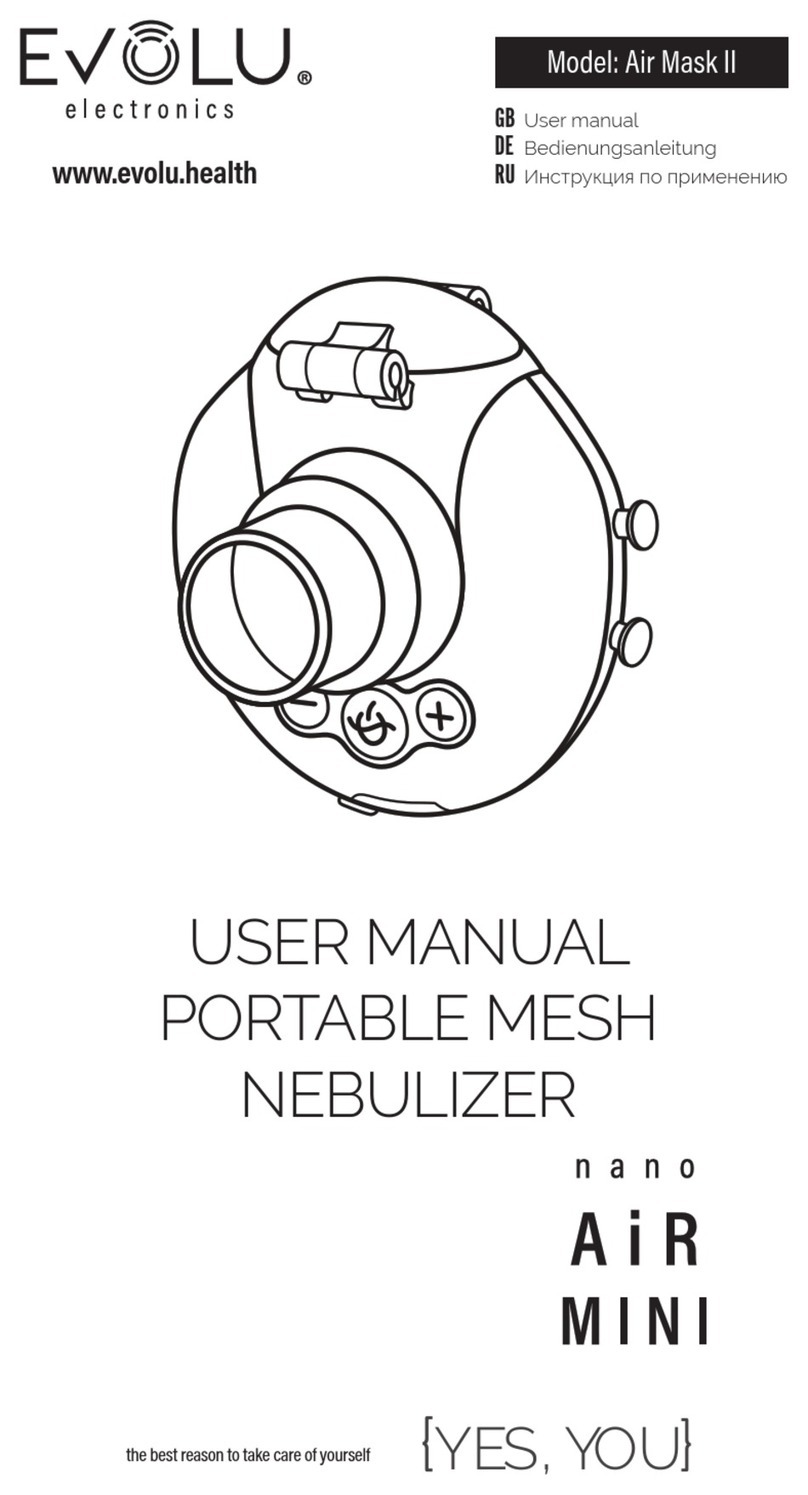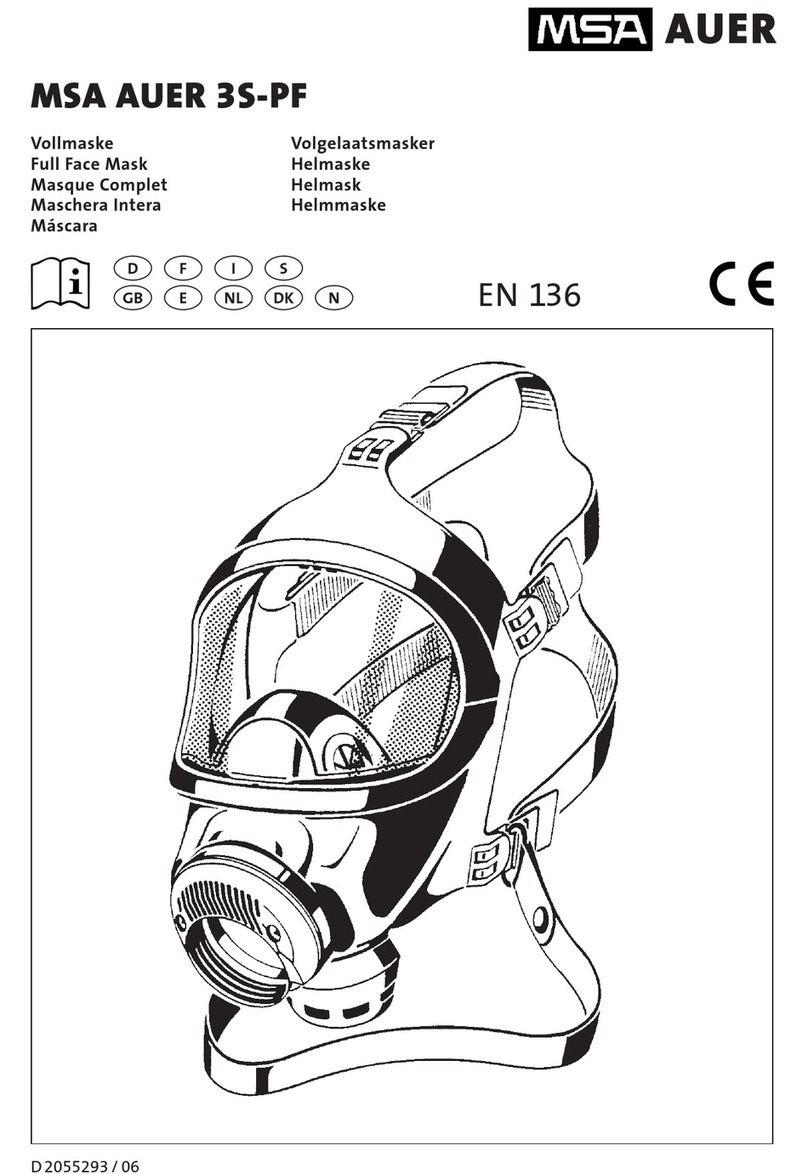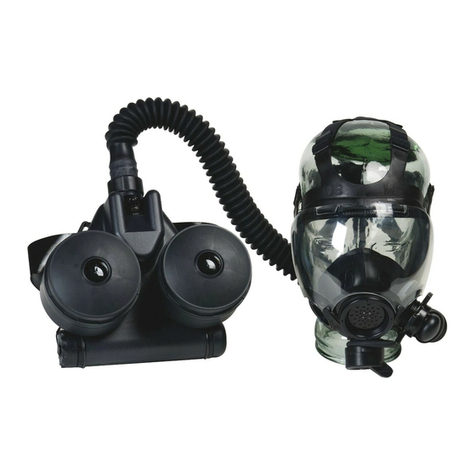
3352488 (A3-D-P)
PAS Colt Series
Airline SAR respiratory protection equipment
Instructions for Use
1
21
3629
2
1611/1612
3
3625
5
3692
4
3626
1
2
3
1 For your safety
1.1 General safety statements
• Before using this product, carefully read the Instructions for
Use.
• Strictly follow the Instructions for Use. The user must fully
understand and strictly observe the instructions. Use the
product only for the purposes specied in the Intended Use
section of this document.
• Do not dispose of the Instructions for Use. Ensure that they are
retained and appropriately used by the product user.
• Only fully trained and competent users are permitted to use
this product.
• Comply with all local and national rules and regulations
associated with this product.
• Only trained and competent personnel are permitted to
inspect, repair and service the product. Dräger recommends a
Dräger service contract for all maintenance activities and that
all repairs are carried out by Dräger.
• Properly trained service personnel must inspect and service
this product as detailed in the maintenance section of this
document.
• Use only genuine Dräger spare parts and accessories, or the
proper functioning of the product may be impaired.
• Do not use a faulty or incomplete product, and do not modify
the product.
• Notify Dräger in the event of any component fault or failure.
• Before occupational use of this respirator a written respiratory
protection program must be implemented meeting all the local
government requirements. In the United States employers
must comply with OSHA 29 CFR 1910.134 which includes
medical evaluation, training, and t testing.
1.2 Denitionsofalerticons
Alert icons are used in this document to provide and highlight text
that requires a greater awareness by the user. A denition of the
meaning of each icon is as follows:
!
WARNING
Indicates a potentially hazardous situation which, if not
avoided, could result in death or serious injury.
CAUTION
Indicates a potentially hazardous situation which, if not
avoided, could result in physical injury or damage to the
product or environment. It may also be used to alert against
unsafe practices.
i
i
NOTICE
Indicates additional information on how to use the
product.
2 Description
2.1 Product overview
This variant of the Dräger PAS Colt Series provides respiratory
protection for working in a contaminated environment using an
airline (supplied airline respirator – SAR). During use, the PAS
Colt is connected to a breathing-quality independent air supply.
The features of the equipment are:
• The carrying system is a bandolier shoulder harness and waist
belt.
• The lung demand regulator (LDR) has a reset button (Fig 1,
Item 1) that switches off the air ow through the regulator,
and a purge button (Fig 1, Item 2) that can be used to deliver
an additional airow into the face mask when required by the
wearer during airline use. The holder (Fig 2, Item 1) provides
a stowage point to protect the regulator coupling and O-ring
against damage when it is not tted in the face mask.
• The airline connector (Fig 2, Item 3) is a male coupling that is
used to connect an independent air supply for SAR (supplied
airline respirator) use.
• A low-pressure whistle is tted on the airline manifold (Fig 2,
Item 2) of some variants of this product. If the PAS Colt is
tted with a low-pressure whistle, the whistle sounds during
airline use to warn the wearer that the independent air supply
has fallen below the required pressure. See the technical data
(Section 9) for the whistle operating pressures.
2.2 Intended use
When this product is used with an approved face mask and
independent air supply, it provides the wearer with respiratory
protection for working in contaminated conditions. It is intended
for use in applications where a high level of respiratory protection
is required.
The face mask and other accessories used with this product
must be certied Dräger components, assembled in an approved
conguration; otherwise the operation of the device may be
impaired. It is essential that ushing and non-ushing face masks
and lung demand regulators should not be mixed (i.e. only a
ushing-type face mask should be used with a ushing-type lung
demand regulator). Contact Dräger for further information.
2.3 Limitations on use
This product is not suitable for use in IDLH (immediately dangerous
to life and health) atmospheres, and is not approved for use in
CBRN applications.
2.4 Approvals
The PAS Colt Series of airline respiratory protection equipment
conforms to the 19C requirements of NIOSH. This product is
approved for use as a supplied airline respirator (SAR).
3 Use
!
WARNING
The airline air quality shall meet the requirements for
breathing air according to CGA G-7.1 Grade D or higher
quality.
Before using airline equipment, ensure that the independent
air supply meets the air quality requirements and complies
with pressure, ow and hose length requirements in the
technical data (see Section 9), and has been issued with a
permit for use if necessary.
If using a PAS Colt without an integral low-pressure whistle,
Dräger recommend that a low-pressure warning device is
tted to the independent air supply.
3.1 Preparation for use
3.1.1 Visual inspection
Carry out a visual inspection, checking the full breathing equipment
including all component parts and accessories. Check that the
equipment is clean and undamaged, paying particular attention
to pneumatic components, hoses and connectors. Typical signs of
damage that may affect the operation of the breathing apparatus
include impact, abrasion, cutting, corrosion and discoloration.
Report damage to service personnel and do not use the apparatus
until faults are rectied.
3.1.2 Functional testing
!
WARNING
If PAS Colt fails to meet any of the standards or parameters
described in the functional tests, or if an immediate leak is
evident, there is a system fault. Report the fault to trained
service personnel or contact Dräger. Do not use the
breathing apparatus until the fault condition is rectied.
Leakandowtest
1. Press the reset button (Fig 1, Item 1) of the lung demand
regulator.
2. Connect the independent air supply to the male coupling
(Fig 2, Item 3). If the independent air supply air supply has a
shut-off valve, open the valve.
○ There should be no audible leak. If there is any leak,
investigate and repair the leak before use. If necessary,
use a soapy solution to locate the leak.
!
WARNING
Do not direct the airow on to the face, eyes or skin.
3. Press the purge button (Fig 1, Item 2) for 3 to 5 seconds. An
unobstructed airow should ow from the outlet of the lung
demand regulator.
4. Isolate and disconnect the independent air supply.
5. Press the purge button (Fig 1, Item 2) to vent the system and
then press the reset button (Fig 1, Item 1) to switch off positive
pressure.
3.1.3 Putting on the PAS Colt (ready position)
Refer also to Fig 2 which shows the PAS Colt worn in the ready
position.
1. Open the waist belt buckle and fully extend the waist and
shoulder strap.
2. Place the left arm through the shoulder harness, taking the
harness over the head and on to the right shoulder, positioning
the strap diagonally across the body.
3. Loop the waist belt around the waist and fasten the buckle –
do not tighten.
4. Grip the airline manifold (Fig 2, Item 2) with the left hand and
lift until the waist belt is in line with the waist. Then tighten the
waist belt strap until the equipment is secure and comfortable
on the waist. Pull down to adjust the shoulder strap.
5. Inspect the face mask as dened in the relevant instructions
for use.
6. Check that the face mask port and the regulator O-ring clean
and undamaged.
7. Remove the lung demand regulator from the holder and press
it into the port of the face mask until it latches in position.
Check the attachment by gently attempting to pull the coupling
apart.
8. Put the neck strap of the face mask over the head then insert
the neck strap stud into the hole in the centre strap of the head
harness.
3.1.4 Putting on the face mask
1. Press the reset button (Fig 1, Item 1) of the lung demand
regulator to switch off the positive pressure.
2. Connect the independent air supply to the male coupling
(Fig 2, Item 3). If the independent air supply air supply has a
shut-off valve, open the valve.
!
WARNING
Correct t of the face mask can only be achieved if the
complete face mask seal makes contact with skin. Head
hair, facial hair (including beard stubble and sideburns),
earrings, other facial piercings and normal spectacles will
interfere with the face mask seal and are not permitted in
the sealing area. Additionally, head hair that could affect
the face mask t (buns, pony-tails, hairpieces, etc.) is not
permitted.
i
i
NOTICE
Refer also to the face mask instructions for use.
3. Detach the neck strap stud from the center strap of the head
harness.
4. Spread the head harness (Fig 3). Place the chin into the chin
cup of the face mask and pull the harness over the head
locating the harness center plate on back of the head.
5. Referring to Fig 4, tighten both lower (1) and then upper straps
(2) evenly towards back of the head. If necessary, tighten the
center strap (3). The wearer’s rst inhalation after achieving
a face seal will automatically switch on the air supply into the
face mask.
6. Check that the head has a full range of movement without
pulling against the regulator hose. If any resistance to
movement is felt, readjust the hose routing and then recheck.
If resistance is still felt, do not use the breathing apparatus
and contact Dräger.
3.1.5 Function check
1. Isolate the independent air supply (close the valve or
disconnect) and breathe normally to empty the system of
air. When empty, the face mask should hold on to the face to
indicate a positive seal.
2. Immediately reapply the independent air supply and breathe
normally.
3. Inhale and hold your breath – there should be no audible leak.
If a leak is detected, readjust the head harness and retest.
4. Recommence breathing – exhaled air should ow easily out of
the exhalation valve.
5. Momentarily press the purge button (Fig 1, Item 2) to check for
additional airow.
When the function check is satisfactorily completed, breathe
normally and proceed to the working area.
3.2 During use
3.2.1 Escape procedure
i
i
NOTICE
If the PAS Colt is tted with a low-pressure whistle,
during airline use the whistle sounds to indicate that the
independent air supply has fallen below the required
pressure. If the whistle sounds and then stops before the
escape procedure is started, the air supply pressure could
have been restored. The wearer must conrm that the
correct pressure (87 to 125 psi) is available, or escape as
described below.
If the independent air supply fails, breathe normally and
immediately proceed as follows:
1. Disconnect the independent air supply from the PAS Colt.
2. Remove the lung demand regulator from the face mask (Fig 5)
and place it in the holder (Fig 2, Item 1).
3. Immediately leave the hazardous area by the shortest and
safest escape route.
3
2
1


